Introduction
In preparation for reviewing NETGEAR’s R6250, I thought it best to retest its original draft 802.11ac router, the R6300, with the new SNB wireless test process. We last reviewed the R6300 in June 2012.
The R6300 was upgraded to 1.0.2.68 firmware for the retest. This version of firmware adds beamforming support to the router. Unfortunately, ASUS has not yet released beamforming support for the PCE-AC66 adapter that we now use as the standard wireless test client. NETGEAR sent along an A6200 USB draft 802.11ac adapter that also supports beamforming, so I plan to do a separate article taking a look at whether beamforming really does improve performance.
The router was reset to factory defaults and Channel 6 was set for 2.4 GHz and Channel 153 for 5 GHz. 20 MHz bandwidth mode was set for 2.4 GHz and 80 MHz mode (to enable draft 802.11ac link rates) was set for 5 GHz. The test client was connected using WPA2/AES encryption.
The router were positioned 8" from the chamber antennas in the 0° and 180° test positions. The 0° position had the router front facing the chamber antennas.
The retest Benchmark Summary below from the new Consolidated benchmark process shows the average of throughput measurements made in all test locations.
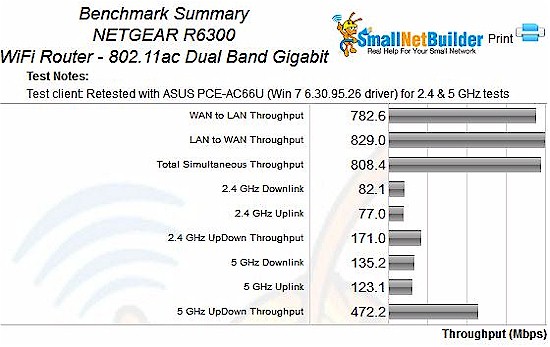
NETGEAR R6300 Retest Benchmark Summary
The 2.4 GHz values in the summary above correspond to the 2.4 GHz 3-stream values (20 MHz B/W) and the 5 GHz values above correspond to the 80 MHz B/W – 3 stream values in the previous review. Compared to the results in the last review’s benchmark summary, the 2.4 GHz unidirectional values have risen around 30 Mbps each and the simultaneous up/down benchmark by about 50 Mbps. Gains were much lower for 5 GHz unidirectional values; about only 10 Mbps. The only benchmark to dramatically increase is the 5 GHz UpDown Throughput, which doubled from 237 to 472 Mbps.
Now that we have a few retests and full throughput vs. attenuation plotting at our disposal, let’s cut to the chase and see how the retested R6300 stacks up against other AC1750 routers. The following plots show the R6300, ASUS RT-AC66U, Linksys EA6500 and WD My Net AC1300.
2.4 GHz downlink shows about equal performance among the group at higher signal levels (lower attenuation values). But when the throughput of the rest of the group starts to fall at the 33 dB point, the ASUS declines at a slower rate. The R6300’s best rate for this test was 123 Mbps with 3 dB of attenuation.
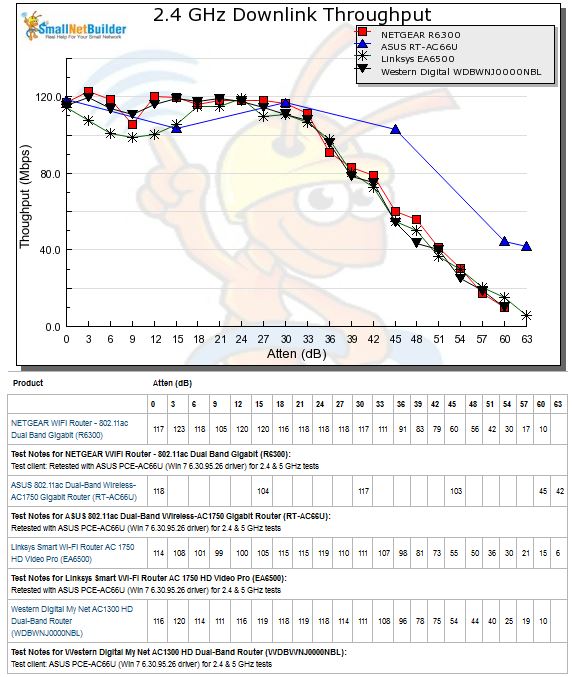
2.4 GHz Downlink Throughput vs. Attenuation
The 2.4 GHz uplink plot shows a very tight cluster for the same three products up to the 27 dB point, where they all start their downward slope. The ASUS once again falls off with a much gentler slope. The R6300’s highest measured throughput for this benchmark was 119 Mbps at a few points on the curve.
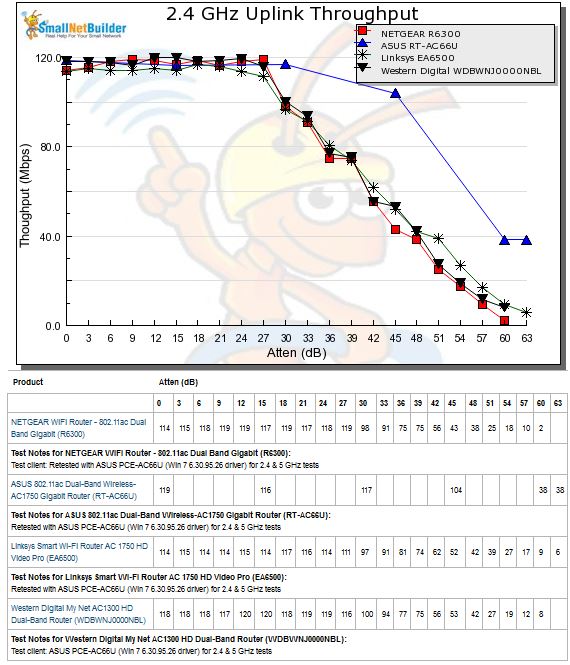
2.4 GHz Uplink Throughput vs. Attenuation
The R6300’s 2.4 GHz simultaneous uplink/downlink test in the strongest signal "Location A" (or with 0 dB attenuation) measured 171 Mbps. This is actually the best of the four routers compared.
The 5 GHz tests, which show draft 802.11ac performance show a bit more spread in performance. The 5 GHz downlink test summary below shows that the ASUS actually doesn’t turn in the highest throughput of the group. That distinction goes to the WD My Net AC1300 with 352 Mbps. The R6300’s best case for this benchmark is 297 Mbps.
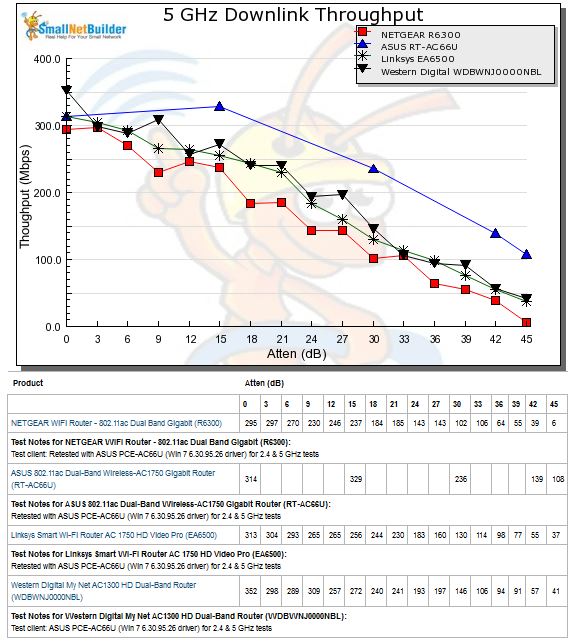
5 GHz Downlink Throughput vs. Attenuation
The 5 GHz uplink plot shows even more variation. This time, the R6300 takes the middle ground at higher signal levels, starting out at its peak value of 258 Mbps. As signal levels drop, the R6300’s throughput falls off a bit faster than the others, crossing under the Linksys EA6500’s at 30 dB of attenuation.
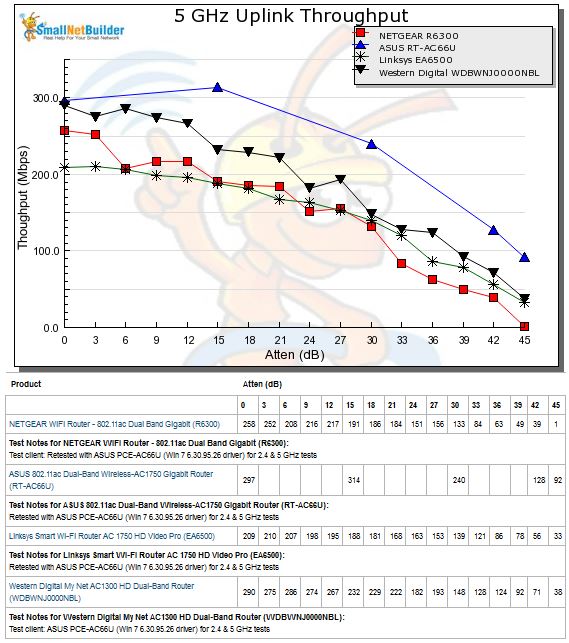
5 GHz Uplink Throughput vs. Attenuation
The R6300’s simultaneous up/downlink throughput was the lowest of the group at 472 Mbps. The WD My Net AC1300 actually lead the pack for this benchmark with 555 Mbps of total up and downlink throughput.
Since I make four runs, rotating the router under test 90° each time, I get a sense of how directional the router’s performance is. Since my test chamber is small, I don’t want to unfairly penalize products that are more directional than others. So I don’t always take the average of the four runs. When there is a big spread among the four test runs, I choose the one with the best results, as long as the "best" is consistent for down up and downlink runs.
So that you can see the variation for yourself, the plot below shows the four runs for the R6300, with the run I used—the "0°"—bolded.
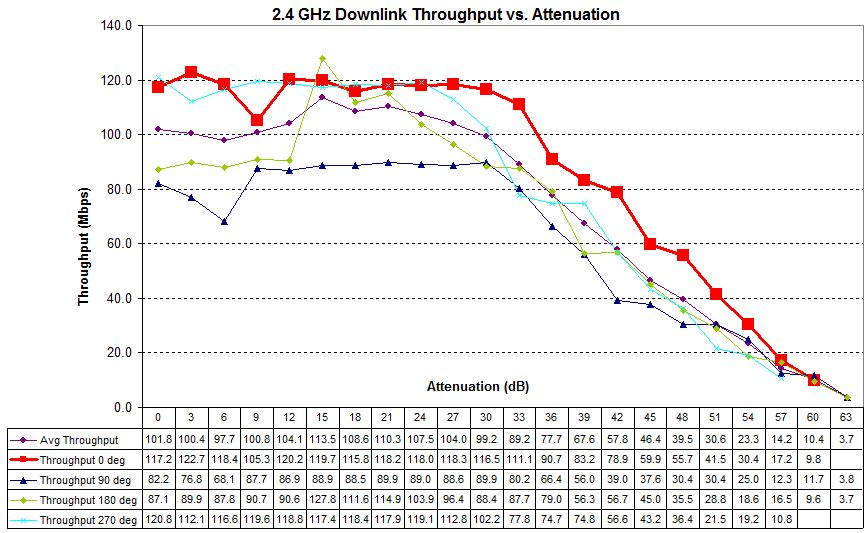
Four test runs – 2.4 GHz downlink – NETGEAR R6300
And here is what the variation in the 5 GHz runs looked like.
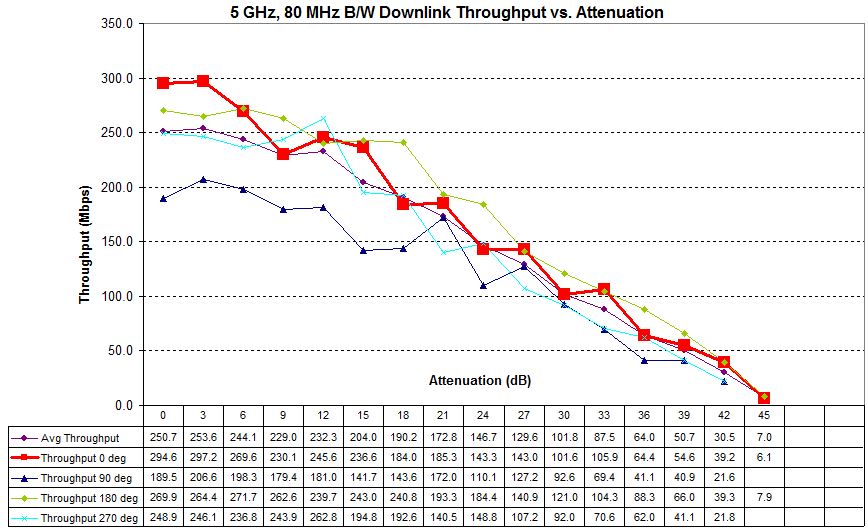
Four test runs – 5 GHz downlink – NETGEAR R6300
Closing Thoughts
Since all the AC1750 routers except one—the Buffalo WZR-D1800H—in the Router Ranker AC1750 class have now been tested with the new wireless test process, the ranking is really apples-to-apples. The R6300 ties for the #3 spot with the Linksys EA6500 in Total router ranking, which includes both wired and wireless performance.
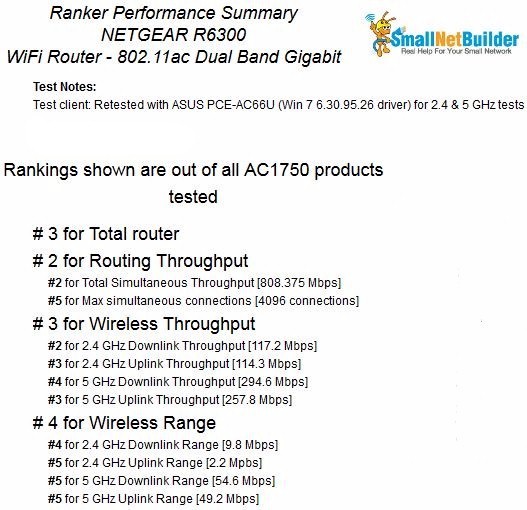
NETGEAR R6300 Router Ranking Summary
The detailed ranking summary above shows that the R6300’s weakest point is range, which is evident in the throughput vs. attenuation plots shown earlier. The ASUS RT-AC66U, which ranks #1 across the board, still looks like the one to beat when it comes to performance in AC1750 class routers.
